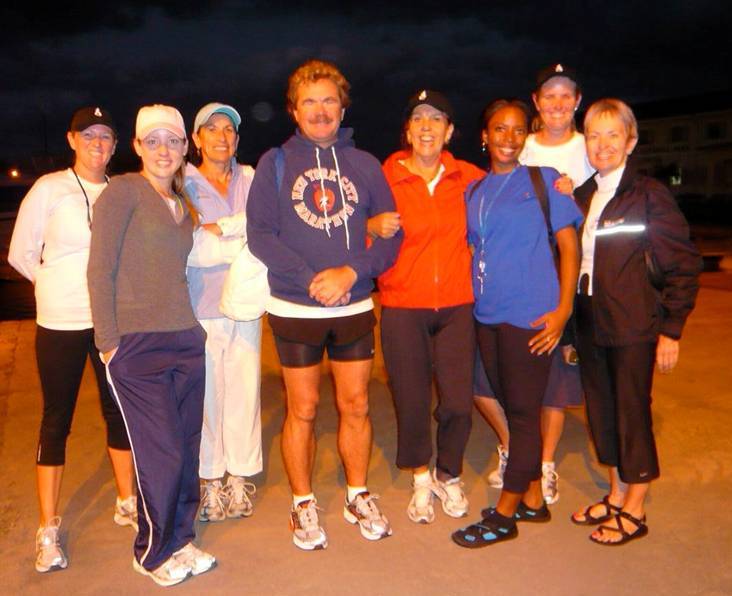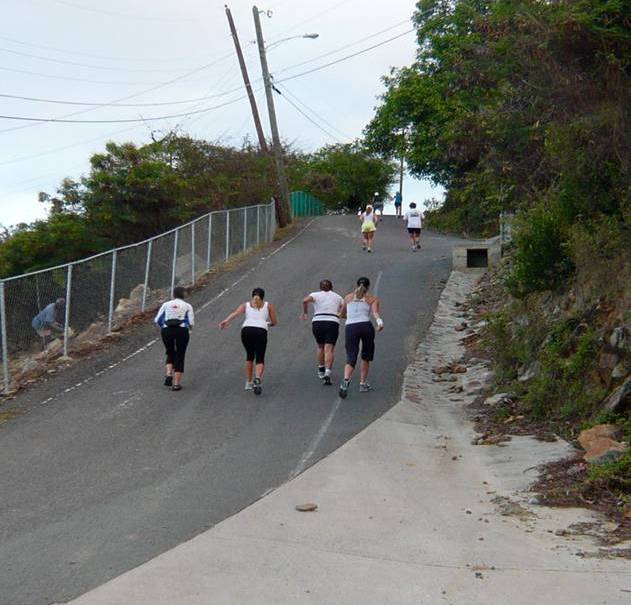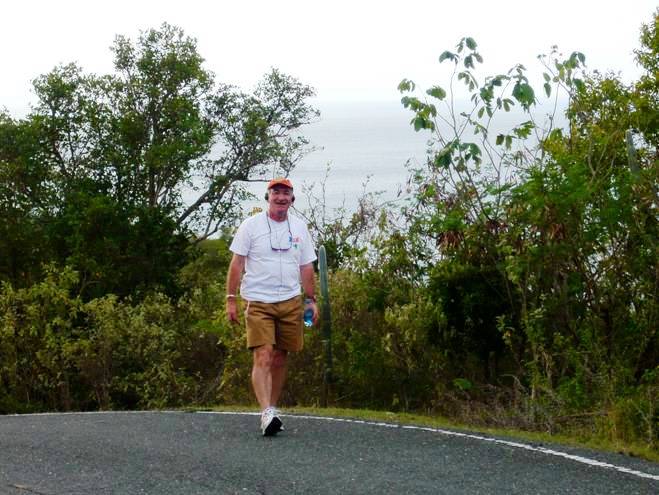|
INTERNATIONAL FELLOWSHIP OF RUNNING AND
FITNESS
ROTARIANS
Chair: PDG
Harold Friend (Boca Raton/6930),
Vice
Chair: Toshi
Ihara (Hiroshima West/2710)
Newsletter Editor:
Kevin McAuliffe (Tokyo Hiroo/2750 )
Letter from the Editor --
In this issue of the IFRFR newsletter Rotarian Jan Robinson
writes about a fund raiser in St . Thomas that combines the
Fellowship’s goals of running and fitness along with a service
above self theme.
In addition there is the summary of a Stanford University
study on the benefits of running for the middle aged and beyond
and an analysis from Harvard Health on the merits of BMI and
other ways to measure whether we are overweight and the risks
attached.
For those attending the RI convention in
Birmingham in June, please stop by the IFRFR booth and if you
have time volunteer to staff it for a short time.
Vice Chair Toshi Ihara will be at the booth some of the
time but we could use additional help.
No experience necessary and it is an excellent way to
meet other like-minded Rotarians.
Please contact either Harold Friend or Toshi Ihara at the
e-mail addresses above if you can help at the convention.
+
+ +
ROTARY CLUB OF ST.
THOMAS, U.S. VIRGIN ISLANDS – FUND RAISER “THE ST. JOHNATHON -
13 MILE WALK/RUN” By Jan Robinson
On March 8, 2009, six Rotarians -
Marston Winkles, Roger White, Jan Robinson, Jane Wherren,
Wein Demitros, and Sam
Felder, participated and completed the sponsored walk
across the island of St. John, a distance of thirteen miles from
Hanson Bay to Cruz Bay. This requires starting at sea level,
walking up to an elevation of 1,000 feet and then back down to
sea level, several times; hills, hills, and more hills. Personal
best times were broken and more than $13,000 was raised.
Marston Winkles started this fundraiser
with two other Rotarians, four years ago. The Rotary Club of St.
Thomas is continuing its support for Rotary’s efforts to assist
with land mine issues, which, on some level, affects people in
over 60 countries around the world. We were able to leverage the
funds raised from the 2006 sponsored walk to obtain further
grant money from other areas of Rotary International for a total
of $24,600. This has assisted 155 land mine victims of the
twenty-year civil conflict in Northern Uganda with lower body
prosthetic limbs and provided them with agricultural tools to
assist them to be productive members of their society. In round
terms this means that for every sponsorship dollar that was
given, it enabled us to generate $4 of assistance.
The 2007 funds have been used to contribute
to a cooperative effort involving the Rotary Cub of St. Thomas
and two Rotary clubs in Denmark as well as our Rotary colleagues
in Uganda. The clubs have supplied resettlement assistance to
400 families, representing over 2,000 people, to enable them to
move from the displacement camps and reestablish themselves back
in their villages. We also continued to provide education
assistance to a further 10 former child soldiers to enable them
to restart their interrupted education. This continues the theme
of our assistance in the past and is what has been chosen by the
Rotarians in Uganda who identify the need and then carry out the
project on the ground.
From the 2008 fundraiser, we are again
working with our Rotary colleagues in Denmark and Uganda on a
further project involving resettlement.
The leverage we have been able to achieve
in order to obtain equipment for the automotive repair section
of the Vocational Education Department of Charlotte Amalie High
School has been even better. We are working on another project
with our adopted school to continue to provide relevant work
related skills to non-college-bound students, again thanks to
the support we receive.
The three projects we are supporting this
year are:
1. To provide further supplies to the
Vocational Education department of the Charlotte Amalie High
School.
2. To support Rotary’s efforts in land
mine eradication and victim support in Uganda.
3. To provide assistance to the Savan
Boys Club in St. Thomas (an after school program for at-risk
youth)
P.S. from Sam (Sylvia) Felder
“When I decided to participate in the St.
Johnathon, I had no idea what I had actually signed up for. My
very first preview was the previous Monday while I was showing
my friends from Oregon the island of St. John. What had I done?
The walk looked absolutely IMPOSSIBLE!
My whole inspiration was Jan Robinson,
my dear friend and Rotarian who was now sporting two new hips.
My thought was if she could do it; so could I. Well, I finished
as the last turtle across the line after 13 steep, tough
hills all the way to Cruz Bay. My friend, Toni Lacer joined me
after the first five miles in Coral Bay and helped me make it
through. I amazed myself and definitely felt entitled to a few
bragging rights to my friends and family. “WHEW! What a
walk....”

Group
at 5.45 a.m. in Cruz Bay

Start of walk/run Hanson Bay, St. John

Roger
White up the hill
+ + +
Decades-Long Analysis Finds Older Runners Reap Survival Benefits
From:
Arch Internal Med, 2008,
Vol. 168, No. 15, pp. 1638-1646
A 21-year
study has found that running regularly in middle age and beyond
is an effective means of staving off disabilities later, and may
increase lifespan. The study comes from the Division of
Immunology and Rheumatology in the Department of Medicine at
Stanford University in California. It was conducted over two
decades on northern California residents aged 50 and over.
The analysis
started in 1984, and looked at 538 members of a national masters
(50+) running club. The control group was made up of 423 healthy
nonmembers of similar age. Annual questionnaires were given,
asking both groups to report running and exercise frequency,
BMI, and disability as assessed by the Health Assessment
Questionnaire Disability Index, which scores from zero (no
difficulty) to three (unable to perform). Various techniques
compared groups on disability and mortality.
At the start,
the runners were leaner and less likely to smoke than the
controls. They were also younger. Nevertheless, after adjusting
for these factors, runners lived longer and healthier. The mean
disability factor was higher for the control group at every time
period measured though it increased with age in both groups, but
to a lesser degree in runners. After 19 years, 15% of runners
had died, compared to 34% of controls. After 21 years, 284
runners and 156 controls remained. In addition to lower
disability scores reported among the running group, it took much
longer for runners to reach various levels of disability.
The study
recommends moderate to vigorous exercise at middle age (and
older) for improved health and general wellbeing.
+ + +
A Simpler Approach to Fat Measure
From: Harvard Health Publications, Harvard Health
Letter, Jan. 09
Most of us have our private ways of assessing how fat we are. We
feel our pants getting snug, notice certain lumps and curves
during the morning shower, perhaps feel the breathless pinch of
the growing midsection as we back out the car or tie our shoes.
But there are more objective ways to answer the question—even if
they borrow from these time-tested “techniques.” One thing is
certain, the simpler the better. Still, body fat measurement
benefits from a triangular approach.
Body mass index, or BMI, is computed by taking your weight in
kilograms and dividing it by the square of your height in
meters. BMI is easy to calculate, and in most people, it
correlates reasonably well with overall body fat. It’s also a
good measure of health risk: as a rule, when BMIs go up, so do
deaths, particularly from cardiovascular disease. But BMI
doesn’t distinguish whether the pounds are from fat or from
fat-free tissue like muscle and bone. This can be an issue with
runners and other athletes, but it also affects those on the
opposite end of the continuum. Certain people with BMIs in the
normal range are at risk because, while their body weight is not
necessarily excessive for their height, more of their weight is
simply made up of fat. BMI also doesn’t tell us about the type
of fat we’re carrying—a significant shortcoming, as the type of
fat that builds up in the abdomen is believed to be particularly
unhealthful.
Waist measurement puts a different spin on obesity: it’s no
longer about weight or total body fat, but about the
metabolically active fat that collects around the organs in our
abdomens. In fact, there’s mounting evidence that waist
circumference makes a better predictor of diabetes than BMI, and
a rather good indicator of heart disease risk. Measuring waist
circumference identifies the sizable group of people who pass
muster when it comes to BMI but whose large waists put them at
higher risk. Still, waist measurement hasn’t become part of
routine medical practice for several reasons.
For one thing, there’s some uncertainty about exactly where the
waist should be measured, although navel-level is widely
accepted. And given all the other information that’s collected
on patients—blood pressure, cholesterol levels, BMI—it’s not
certain that adding a waist measurement to the mix would affect
treatment decisions. The real benefit of this measurement comes
from its simplicity and therefore its ability to be
self-administered.
To measure your waist circumference, locate the upper hip bone
and place a measuring tape around the abdomen (ensuring that the
tape measure is horizontal). The tape measure should be snug but
should not cause compressions on the skin. Then use the
following guidelines:
1. Regardless of waist circumference, a BMI of under 25 is
considered normal weight. The healthy cut-off for waist
circumference in a man is 40 inches and for a woman 35 inches,
but no data exists on whether there are health issues related to
greater waist sizes than this with a BMI in the normal range.
2. At a BMI of 25 to 29.9 with a waist circumference of up to 40
inches for men, risk of BMI-related disease is “increased”. For
women, this remains the same as for men but with a waist
circumference cut-off at 35 inches. And at this BMI, a waist
circumference of over 40 in men (and over 35 in women) puts the
risk at “high”.
3. At a BMI of 30 and higher with a waist circumference for men
of up to 40 inches (35 in women), these risks change from “high”
to “very high”. If you are under 40 inches (35 in women), then
these risks are categorized as merely “high”.
As the above information illustrates, the problem with relying
on waist circumference is that, as an absolute value with a kind
of warning-system mentality, it is not that useful for modestly
out-of-shape people looking to trim up and then assess what a
good waist size may be. Moreover, the definition of “too large a
waist” may need revision: some studies show that health risks
start well before the current cut-offs.
Waist circumference’s predecessor, waist-to-hip ratio (WHR),
works like BMI, on a proportional scale, but with the added
value of scrutinizing midsection fat.
The WHR is a simple calculation: waist circumference divided by
hip circumference. A small waist combined with big hips yields a
smaller number than a big waist with small hips—and smaller is
better when it comes to WHR. For women, the risk for heart
disease, stroke, and other health problems starts to climb at a
ratio of about 0.85, so that is often set as the cut-off for a
“good” ratio. For men, the cut-off is at about 0.90. (.89
translates to a 32-inch waist with 36-inch hips.) Waist
circumference has eclipsed WHR, but the WHR may be ready for a
comeback. Research shows that WHR is more strongly associated
with heart disease than waist circumference alone. By taking hip
circumference into account, the ratio is more sensitive to the
difference between dangerous abdominal fat and the less harmful
layer of fat we carry under the skin throughout the body.
Your waist-to-hip ratio is an important tool that helps you
determine your overall health risk. People with more weight
around their waist are at greater risk of lifestyle related
diseases such as heart disease and diabetes than those with
weight around their hips. It is a simple and useful measure of
fat distribution.
Use a measuring tape to check the waist and hip measurements.
1. Measure your hip circumference at its widest part.
2.
Measure your waist circumference at the belly button or just
above it.
3. Divide 2. by 1.
And so it seems you really need all of these tools together.
Each fat measuring tool tells you one thing in relation to the
others, and by triangulating the data a picture emerges of your
overall health, fitness level, and risk of overweight or
obesity-related disease.
+ + +
International Fellowship of Running and Fitness Rotarians
MEMBERSHIP APPLICATION
Would you be interested in serving?
IFRFR, as all Rotary activities, needs volunteers to
serve as officers and to support specific activities. Indicate
your interest:
Name:_________________________________________________________________
Address:_______________________________________________________________
City:_____________________________________State/Provence:_________________
Country:______________________________Postal/Zipcode:______________________
Email:______________________________________Phone:_______________________
District/RotaryClub:_______________________Classification:_____________________
_____New ($25) for 2 years (includes IFRFR
pin)
______Renewal ($20) for 2 years
_____Rotary Life ($100) (includes pin)
Mail payments (Send check made out to
Rotary (US bank, traveler’s check or cash)
or send credit card information (charge
will appear as Boca Neurology):
PDG Harold Friend, MD
1500 NW 10th
Ave. # 105
Boca Raton, FL 33486, USA
The International Fellowship of Running and Fitness Rotarians is a group of Rotarians
dedicated to promoting running, fitness and health as an opportunity for fellowship and service.
This fellowship operates in accordance with Rotary International policy, but is not an agency of,
or controlled by, Rotary International.
|

